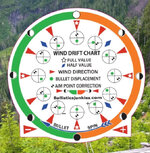aschuler
Lil-Rokslider
I really enjoyed this video describing how to apply Litz's WEZ to hunting scenarios. The whole series (this is #4) is worth a listen.
I haven't used WEZ but I've read Litz's books, the linked whitepapers and other materials. From that material my understanding is that there are four inputs. Precision for: 1.Wind, 2.Range Estimation, 3.Rifle/Ammo Precision, and 4.Velocity Consistency
My question is about #3 Rifle/Ammo Precision, and that is what the video's discussion centered around. Starting at about 7:00 in the video he's talking about rifle/ammo precision in terms of MOA, which is pretty straight forward. Adding 0.5 MOA of precision only affects the hit probability by 5% or less. Great argument and the examples are from 0.5MOA to 1.5MOA systems.
At about minute 8:15 he goes on to say the largest source of error is the shooter. "We suck at shooting". Things like bad form, improper zero, loss of zero etc. What I'm wondering is, shouldn't that be modeled in the Rifle/Ammo Precision input? it seems like we could include the "we suck" part in that input. I don't think the loss of zero would work of course. Am I missing something here?
Anyway, it's a good listen and thanks for those that are producing these.

